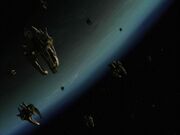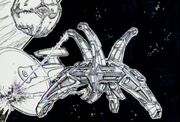EtaPiscium (talk | contribs) mNo edit summary |
m (Robot: Automated text replacement (-==Background== +== Background information ==)) Tag: apiedit |
||
| (32 intermediate revisions by 20 users not shown) | |||
| Line 1: | Line 1: | ||
| − | [[ |
+ | [[File:Cardassian orbital weapon platform.jpg|thumb|A group of platforms sit deactivated in a holding orbit.]] |
| ⚫ | |||
| + | ==History== |
||
| ⚫ | |||
| + | [[File:Cardassian orbital weapon platform graphic.jpg|thumb|left|A schematic of an orbital weapon platform.]] |
||
| − | |||
| − | The platforms were developed in late [[2374]], when the [[Cardassian Union]] and the [[Dominion]] were embroiled in fighting on three separate fronts, with the [[ |
+ | The platforms were developed in late [[2374]], when the [[Cardassian Union]] and the [[Dominion]] were embroiled in fighting on three separate fronts, with the [[Federation]], the [[Klingon Empire]], and the [[Romulan Star Empire]]. Faced with the prospect of being outnumbered, the Cardassians began developing the automated defense platforms as a means of cheaply defending their home territories, allowing fleet resources to be deployed on the offensive. |
The first platforms were deployed in the [[Chin'toka system]], since the system's defending forces had been thinned substantially. In the subsequent [[first Battle of Chin'toka|allied attack]], the platforms demonstrated their superior firepower against the allied fleet, scoring numerous kills against larger [[starship]]s. Their regenerative deflector shielding also protected the platforms from return fire, rendering them nearly invulnerable. |
The first platforms were deployed in the [[Chin'toka system]], since the system's defending forces had been thinned substantially. In the subsequent [[first Battle of Chin'toka|allied attack]], the platforms demonstrated their superior firepower against the allied fleet, scoring numerous kills against larger [[starship]]s. Their regenerative deflector shielding also protected the platforms from return fire, rendering them nearly invulnerable. |
||
| + | [[File:USS Galaxy.jpg|thumb|The {{USS|Galaxy}} takes on an orbital weapon platform]] |
||
| − | However, the network of platforms possessed a crucial design flaw that the Cardassians had not expected the allies to be able to exploit. |
+ | However, the network of platforms possessed a crucial design flaw that the Cardassians had not expected the allies to be able to exploit. In order to decrease the mass (and complexity) of the platforms as much as possible, and still supply them with enough energy, the individual platforms were not equipped with their own power source but instead received energy from a large central generator. This generator was placed on an [[asteroid]] [[moon]] orbiting one of the [[planet]]s in the system. |
| + | |||
| ⚫ | Although a frontal attack against the power generator proved futile due to the generator's high-powered shields, the allies developed a means of tricking the automated platforms into firing on their own power source by imprinting a Federation [[warp signature]] on the generator. The gamble was successful, and with their power source destroyed, the weapon platforms deactivated. ({{DS9|Tears of the Prophets}}) |
||
| + | |||
| ⚫ | Despite the enormous potential of the weapon platforms, they proved of little use through most of the remainder of the war. Although information on the Cardassian military's assessment of their performance at Chin'toka is unknown, it seems apparent that the design flaw was severe enough to delay the deployment of additional platforms for at least a year. No other networks were encountered by the allies until the [[Battle of Cardassia]], in late [[2375]], when the [[Federation Alliance]] encountered several of these platforms in [[orbit]] of [[Cardassia Prime]]. [[Starfleet]] was to attack the platforms, but, fortunately, the [[Female Changeling]] surrendered to the Alliance before the battle came. ({{DS9|What You Leave Behind}}) |
||
| + | |||
| + | == Background information == |
||
| + | [[File:Orbital weapon platform sketch.jpg|thumb|[[John Eaves]] sketch of orbital weapon platform]] |
||
| + | During the making of "Tears of the Prophets", [[Terri Potts]] commented to the sound editors about the orbital weapon platforms that ''"You'll have fun with them. They're Cardassian, but different from anything that we've ever done before"''. [[Ruth Adelman]] added ''"They're state of the art"''. (''[[Star Trek: Action!]]'') |
||
| + | ==External link== |
||
| + | * {{mbeta}} |
||
| + | [[Category: Weapons]] |
||
| ⚫ | Although a frontal attack against the power generator proved futile due to the generator's high-powered shields, the allies developed a means of tricking the automated platforms into firing on their own power source by imprinting a Federation [[warp signature]] on the generator. The gamble was successful, and with their power source destroyed, the weapon platforms deactivated. ( |
||
| + | [[de:Orbitale Waffenplattform]] |
||
| ⚫ | Despite the enormous potential of the weapon platforms, they proved of little use through most of the remainder of the war. Although information on the Cardassian military's assessment of their performance at Chin'toka is unknown, it seems apparent that the design flaw was severe enough to delay the deployment of additional platforms for at least a year. |
||
| + | [[nl:Wapenplatform]] |
||
Revision as of 12:34, 24 October 2015

A group of platforms sit deactivated in a holding orbit.
Orbital weapon platforms were a type of powerful, automated planetary defense system developed by the Cardassian military during the Dominion War. They were protected by regenerative force fields and equipped with three heavy disruptors and 1,000 plasma torpedoes.
History

A schematic of an orbital weapon platform.
The platforms were developed in late 2374, when the Cardassian Union and the Dominion were embroiled in fighting on three separate fronts, with the Federation, the Klingon Empire, and the Romulan Star Empire. Faced with the prospect of being outnumbered, the Cardassians began developing the automated defense platforms as a means of cheaply defending their home territories, allowing fleet resources to be deployed on the offensive.
The first platforms were deployed in the Chin'toka system, since the system's defending forces had been thinned substantially. In the subsequent allied attack, the platforms demonstrated their superior firepower against the allied fleet, scoring numerous kills against larger starships. Their regenerative deflector shielding also protected the platforms from return fire, rendering them nearly invulnerable.

The USS Galaxy takes on an orbital weapon platform
However, the network of platforms possessed a crucial design flaw that the Cardassians had not expected the allies to be able to exploit. In order to decrease the mass (and complexity) of the platforms as much as possible, and still supply them with enough energy, the individual platforms were not equipped with their own power source but instead received energy from a large central generator. This generator was placed on an asteroid moon orbiting one of the planets in the system.
Although a frontal attack against the power generator proved futile due to the generator's high-powered shields, the allies developed a means of tricking the automated platforms into firing on their own power source by imprinting a Federation warp signature on the generator. The gamble was successful, and with their power source destroyed, the weapon platforms deactivated. (DS9: "Tears of the Prophets")
Despite the enormous potential of the weapon platforms, they proved of little use through most of the remainder of the war. Although information on the Cardassian military's assessment of their performance at Chin'toka is unknown, it seems apparent that the design flaw was severe enough to delay the deployment of additional platforms for at least a year. No other networks were encountered by the allies until the Battle of Cardassia, in late 2375, when the Federation Alliance encountered several of these platforms in orbit of Cardassia Prime. Starfleet was to attack the platforms, but, fortunately, the Female Changeling surrendered to the Alliance before the battle came. (DS9: "What You Leave Behind")
Background information

John Eaves sketch of orbital weapon platform
During the making of "Tears of the Prophets", Terri Potts commented to the sound editors about the orbital weapon platforms that "You'll have fun with them. They're Cardassian, but different from anything that we've ever done before". Ruth Adelman added "They're state of the art". (Star Trek: Action!)
External link
- Cardassian orbital weapon platform at Memory Beta, the wiki for licensed Star Trek works
